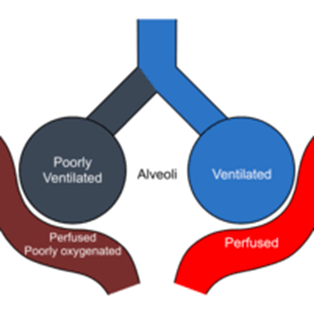A nurse is caring for a client who has a cerebral aneurysm. In the event of a ruptured cerebral aneurysm, which of the following manifestations would be present in the client?
(Select All that Apply.)
Light sensitivity
Loss of consciousness
A dilated pupil
Visual disturbances
Nausea and vomiting
Numbness on one side of the face
Correct Answer : B,C,D,E
Choice A Reason:
Light sensitivity is incorrect. Light sensitivity (photophobia) is not typically a direct manifestation of a ruptured cerebral aneurysm. However, it may occur as a secondary symptom due to other neurological disturbances or increased intracranial pressure.
Choice B Reason:
Loss of consciousness is correct. Loss of consciousness is a common manifestation of a ruptured cerebral aneurysm, particularly if the bleeding leads to significant brain injury or compression of vital brain structures.
Choice C Reason:
A dilated pupil is correct. A dilated pupil (mydriasis) may occur as a result of compression of the oculomotor nerve (cranial nerve III) by the expanding hematoma or increased intracranial pressure following a ruptured cerebral aneurysm.
Choice D Reason:
Visual disturbances is correct. Visual disturbances, such as blurred vision, double vision (diplopia), or loss of vision, may occur due to compression of the optic nerve or damage to visual pathways as a result of the hemorrhage.
Choice E Reason:
Nausea and vomiting is correct. Nausea and vomiting are common symptoms associated with a ruptured cerebral aneurysm, often due to irritation of the meninges and increased intracranial pressure resulting from the bleeding.
Choice F Reason:
Numbness on one side of the face is incorrect. Numbness on one side of the face is not typically a direct manifestation of a ruptured cerebral aneurysm. However, it may occur if the hemorrhage affects specific regions of the brain responsible for sensation or if there is associated compression of cranial nerves.
Nursing Test Bank
Naxlex Comprehensive Predictor Exams
Related Questions
Correct Answer is D
Explanation
Choice A Reason:
Myelogram is not appropriate. This imaging test involves injecting contrast dye into the spinal canal to visualize the spinal cord and nerve roots. While it may help identify certain spinal cord abnormalities, it is not typically used as a primary diagnostic tool for multiple sclerosis.
Choice B Reason:
Brain natriuretic peptide (BNP) is not appropriate. This blood test measures the level of BNP, a hormone produced by the heart, which can be elevated in conditions such as heart failure. It is not used in the diagnosis of multiple sclerosis.
Choice C Reason:
Troponin level is not appropriate. Troponin is a protein released into the bloodstream during a heart attack or other heart-related conditions. This test is used to diagnose heart muscle damage and is not relevant to the diagnosis of multiple sclerosis.
Choice D Reason:
Lumbar puncture is appropriate. Also known as a spinal tap, a lumbar puncture involves collecting cerebrospinal fluid (CSF) from the spinal canal for analysis. In the diagnosis of multiple sclerosis, analysis of CSF can help identify certain abnormalities, such as an elevated level of immunoglobulin G (IgG) or the presence of oligoclonal bands, which are often indicative of inflammation in the central nervous system. Therefore, a lumbar puncture is commonly ordered to assist with the diagnosis of multiple sclerosis.
Correct Answer is B
Explanation
Choice A Reason:
Flail chest is incorrect. Flail chest is a condition characterized by multiple rib fractures, causing instability in the chest wall. While it can lead to respiratory distress, it doesn't directly cause ventilation-perfusion (V/Q) mismatch. Instead, it impairs the mechanics of breathing by compromising chest wall integrity.
Choice B Reason:
Emphysema is a chronic obstructive pulmonary disease (COPD) where the alveolar walls are destroyed, leading to a loss of surface area for gas exchange. This results in areas of the lungs that are well-perfused but poorly ventilated, causing a V/Q mismatch. The damage to alveoli leads to impaired ventilation, while blood flow may still be adequate, leading to hypoxemia (low oxygen levels in the blood).
Choice C Reason:
CHF primarily affects the heart’s ability to pump blood effectively, leading to pulmonary congestion and impaired gas exchange. However, it typically causes diffusion defects rather than a direct ventilation-perfusion mismatch. V/Q mismatch may occur secondary to pulmonary edema, but it’s not the primary mechanism of respiratory failure in CHF.
Choice D Reason:
Guillain-Barré syndrome is incorrect. Guillain-Barré syndrome (GBS) is a neurological disorder that affects the peripheral nervous system, leading to muscle weakness and paralysis. While respiratory muscle weakness can occur in GBS, it doesn't directly cause ventilation-perfusion (V/Q) mismatch. GBS primarily affects nerve function rather than lung function.

Whether you are a student looking to ace your exams or a practicing nurse seeking to enhance your expertise , our nursing education contents will empower you with the confidence and competence to make a difference in the lives of patients and become a respected leader in the healthcare field.
Visit Naxlex, invest in your future and unlock endless possibilities with our unparalleled nursing education contents today
Report Wrong Answer on the Current Question
Do you disagree with the answer? If yes, what is your expected answer? Explain.
Kindly be descriptive with the issue you are facing.
